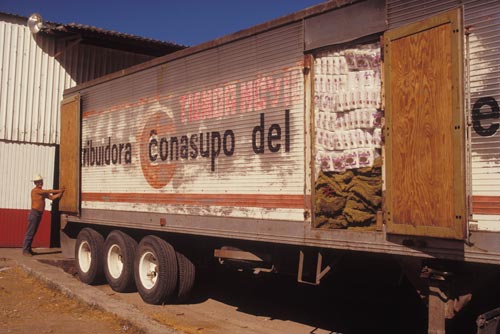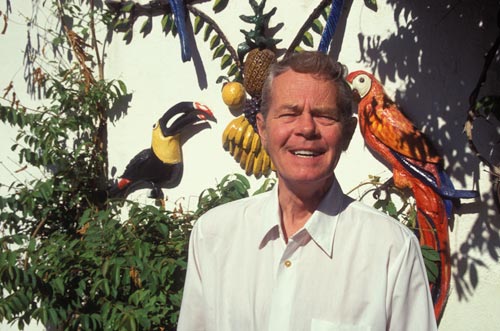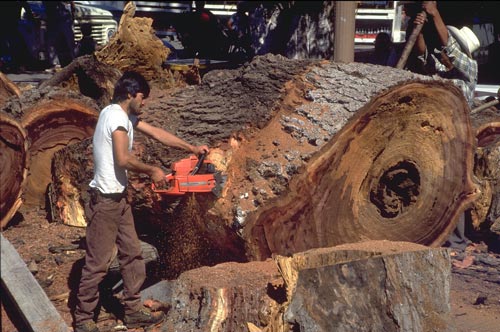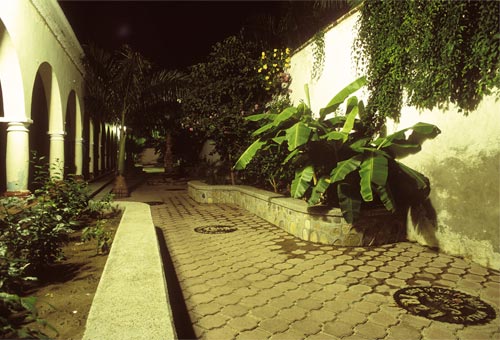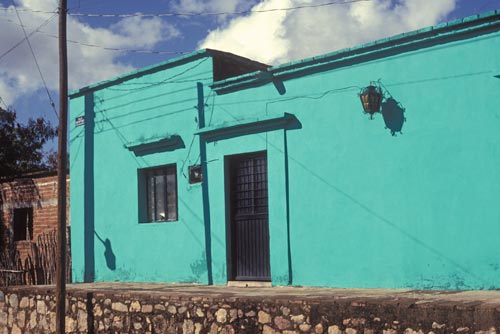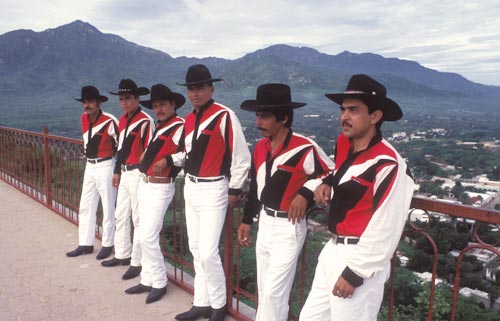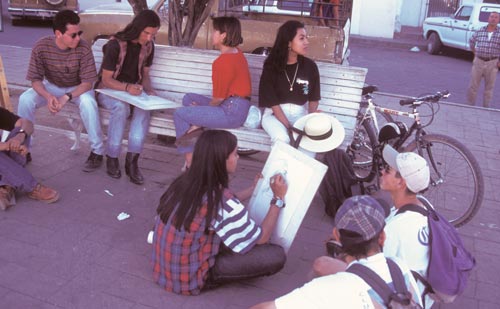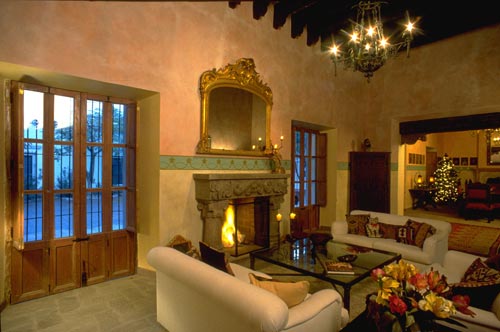Journal entries 31-40
Last modified: June 8, 2013Conasupo comes and goes… workers repairing roofs… Casa Obregon 18… an Alameda tree falls… history walk at Escuela Paulita Verjan… Calle 16 de Septiembre… Casa Esmeralda… traffic cops and artists… Casa de los Santos… Calle Alberto Guitierrez… VW and watermelons… night time in the cemetery…
40 … Government agencies come and government agencies go …
In the mid 60’s Conasupo was created. Conasupo would impact agricultural policies, food products, food consumption and rural economics throughout Mexico. The Alamos Conasupo distribution warehouse was in the barrios northwest of Alamos Centro and served all of the Alamos municipality. Following the debt crisis of 1982, Conasupo was reformed by the Mexican Government as part of a market liberalization process. For villages, ranches and the poor – Conasupo meant access to subsidized food staples like corn tortillas.
Conasupo was seen on signs and trucks throughout Alamos and all of Mexico. It managed stores that sold food staples to the urban and rural poor. Conasupo controlled production, processing and distribution of barley, beans, corn, rice, sorghum, soy beans, wheat, copra, cotton, sesame and sun flowers. It was the Mexican government managing Mexico’s food chain. And it was also human nature taking advantage of opportunities. Corruption and Conasupo were one and the same in the eyes of Conasupo detractors.
During the 80’s and 90’s the Mexican political landscape was changing with intervention of the North American Free Trade Agreement, NAFTA, and the World Trade Organization, WTO. Conasupo began terminating one market-control-crop-subsidy after another. In 1999 the Zedillo administration eliminated corn tortilla subsidies and finally liquidated Conasupo. Direct government intervention in agricultural markets was coming to a close. For the young man above, lifting one heavy sack after another, it meant finding a new job.
39 … Workers on the roofs, a common sight for those looking down …
1770 was a hard year for Alamos, a flood wiped out the newly constructed Alameda and 6,000 people died from the plague. King Charles III of Spain responded to the disaster by sending a Surveyor General tasked with designing a new Alamos street-grid with houses that had adjoining walls to keep squatters out of Centro Alamos. The result is what exists today, Andalucian architecture built by imported maestros from Southern Spain. The mansions’ floor plans, patterned after Roman homes, were either square, U or L shaped surrounding walled courtyards. Then is now.
To have a roof one needs walls. Alamos walls started with four feet of rock and rubble. On top of the “foundation” adobe bricks stacked up to reach fifteen feet high and were two to three feet in thickness. Much of the hard labor was done by Mayo Indians. The wide walls would insulate the interiors and help support the coming roof along with plaster covered columns made of stone or fired brick.
In an coming journal entry we will look at how roofs were made by examining ruins and restorations. Flat roofs do not work that well in Southern Sonora when heavy rains that can not be removed fast enough. It becomes a ever-present vigil to spot leaks before they cause damage to the permanent structure. It is a dance brought on by squalls and summer torrential downpours. It is also wise to watch where one is walking on old roofs, since footsteps can create new leaks. And so it is…
38 … A fanciful garden in Alamos, where art, humans and flora-fauna coexist as one …
Welcome to Casa Obregon 18, now known as Casa Roberto. It is mid-morning on a cloud free summer day. I will meet the owner, Roberto, for a cup of coffee, and then photograph his yard.
I did not know much about Roberto. I was told he came to Alamos with a back pack and stayed to be the hotel Casa de los Tesoros’ cook. After many years at the hotel Roberto took ownership of Casa Obregon 18 and began his creative adventure. As we sat talking in the sala we were surrounded by Roberto’s mosaic paintings. Our conversation was interrupted by a couple of phone calls. It sounded like they were October room reservations. And then he was gone to oversee work taking place in one of his two garages. Roberto seemed to have time only for things that would benefit Roberto, time management is an excellent small business tool. I was left alone to wander through the courtyards.
Casa Obregon, a colonial mansion on hotel row, was built in 1800, and written about in Ida Luis Franklin’s book, Ghosts of Alamos.
The Inn is 4,000 square feet with four bedrooms and four baths. And then there are the yards. Everywhere you look the unexpected appears, lurking or jumping out at you. The checkerboard lawn, with squares made of brick and alternating grass, is a page from Roberto in Wonderland.
This was the third day of no water to central downtown east of the Church. It would be another two days before service was be restored. Today, 2011, Casa Roberto is for sale. The gardens, colors, sculptures and eccentric design can be yours for $550,000 USD. Ghosts are included – free of charge.
It was easy for Roberto to take a moment and flash a big smile for my camera and then go on his way, managing another day, talking to himself under his breath.
37 … A storm hits, a tree falls, man removes tree and repaves street…
Hurricane Fausto, in 1996, uprooted a giant cottonwood tree in the Alameda. There was minor damage elsewhere, but nothing life threatening or forcing people from their homes. In the aftermath men quickly began to cut the tree into large sections. The tree was directly exposed to the winds from the west.
Where does one start to remove a fallen tree? One moves it from the street so traffic can flow again and then one begins to cut it up into smaller pieces: one cut, two cuts, three cuts, four, and … The significance of this photo series is it demonstrates how Alamos continues to be what it is today: build, repair, rebuild, remodel, redecorate, repair, rebuild and…
Man has moved large objects for thousands of years with the understood laws of physics and tools made from available materials. For a brief moment i saw men building pyramids in Egypt, laying out Stonehenge and erecting monuments on Easter Island. It is part of our DNA.
Rebuilding has begun. The missing tree will be memorialized by the new bricks in its place surrounded by weather, oil and rubber stained bricks. Hurricane Norbert, 2008, was one for the history book. It took out all of the Alameda’s remaining cottonwoods. I received a note from Beverly Krucek including this information, “The Alameda has been completely redone….the basketball court removed and a poplar tree lined esplanade built in….antique green benches surround the whole area and it makes a wonderful eye “rest” in the middle of town. The aforementioned basketball court has been moved to a Sports Arena at the entrance of town which also includes a soccer field, baseball, tennis courts and a proposed swimming pool. The next step is to create some sort of recreation center.” Beverly Krucek is involved with the local Alamos History Club which meets most Thursdays fall through spring. And life goes on in Alamos, Sonora, Mexico: The flood of 1770, the hurricane of 2008, the… and it goes on.
36- A walk through modern history at Escuela Paulito Verjan …
The streets are empty. I will see no else on this walk from Calle Comercio to the Middle School and back. But I am not alone. I am with everyone that have walked this very night walk through the years. My shoes fall in their footprints. There is rustling in flowering vines.
How many times as this man took this path to Alamos Centro? How many times has he stopped to read a history medallion? How many times has he appreciated where he is? How many times has he felt grateful this is where his family is? Some of his grand children, at this momen,t may be behind the school’s portales studying.
1684, sixteen-eighty-four, and Alamos is part of the new frontier. Thinking back makes me wonder about the future. 2084, twenty- eighty-four, and what will one see standing in this very spot? And, 2184, twentyone-eighty-four? and… Whoa! Time to take a couple of deep breathes and enjoy being in the present.
History is the record of events occurring and needs being fulfilled. It is easy to ask what came first. The answer, or better yet answers, are part of a grand multiple causation continuum and are not that easy to formulate. But we try, that is part of being human.
This is another milestone in the development of Sonora and all of western settlement. Here, it is easy to answer what came first. First, there was a printing press and then there was a publication. It is the human way. Alamos, Sonora, Mexico has a long and literate history.
35 … A little blue house in Barrio El Barranco…
The sun has just climbed over Red Cross Hill and reached Barrio El Barranco. Everyday details emerge as dark shadows quickly recede into bright sunlight. Notes and rhythms of farm animals, human voices, song and foraging nature presented in rural surround sound replaces town’s sonic-scape of commerce, government, religion, education and tourism.
These roads are traveled on foot, bicycles, cars, trucks, horseback and with burro. Soccer and baseball are played in the open areas. Laundry is washed in a tub by hand and then hung on a line to dry. Leisure time bows to the necessity of thrift and exercise is a healthy by-product of doing without the grid for certain essential tasks.
Life here is not a step backwards from the modern world, it is a life of contemporary balance, reality, and family. Laughs here are as loud as any in Centro Alamos.
Here is a close-up of the casa featured in the preceding photos. The paint is new and adds vibrant visual interest to those passing by on Calle 16 de Septiembre.
The homes are small, families are large with numerous pets and much of the heat and cooking comes from wood. Sticks are a way of life for many.
El Mirador is seen in the background as Calle 16 de Septiembre towards to the left on its way out of town. Soon there will be no road, only a path headed into the surrounding wilderness. The road is filled with kids playing and the oldest care for the youngest. The young boy is serenading the young girl, each with an infant in their arms.
34 … The grand tradition of re-birthing grand traditions as decades turn to centuries…
This is Casa Esmeralda, 1992, beautiful in its own overgrowth, painting peeling, walls cracking, ceilings missing way of being. One sensed she was a former beauty queen, posing outside of town to the northwest, halfway between today’s airport terminal and yesterday’s cathedral. She is waiting for a new adventurer – owner to arrive and serenade her, woo her back to a place she once was, a courtship repeated several times through the years. Through it all, the inclement weather, man’s unending skirmishes, El Camino Real’s dust and accumulated wear and tear from all those she gave shelter to, she is still here.
Oh my, spring 1996 and Casa Esmeralda is looking good with a youthful patina and structural glow. On close inspection, dignified, and understated, workmanship confidently announces itself complete. A transition has taken place. A new direction, anchored in the past, steps boldly into the future. History repeats itself.
Loma de Guadalupe sits in the middle of Alamos, and the barrios, that are south of the new road to Navajoa. Casa Esmeralda can be seen on the right-hand side of Calle Hildago which cuts diagonally across the photo on its way to the airport. Guadalupe Hill is historic ground with encompassing views of Alamos. It is where the jail was, or is, I am not aware of its present location, all I know is that this is prime real estate. At the time of this photo there were 27 men and one woman incarcerated. In the past, there were up to 75 prisoners lodged behind jail walls, with no view, on top of Loma de Guadalupe.
33 … Another day doing what they do, talking about a nice work environment.
The year is 1992, Lupita Dominguez and Clara Miranda Meza are Alamos traffic police women. On weekends and holidays their beat was the Plaza and their job was keeping traffic moving and trouble away. They could also be seen at most special events around town, anything that created traffic situations. They performed other police functions as needed. These were the days when social etiquette frowned on women wearing shorts in public. By my return shoot in 1996, women were wearing shorts everywhere. Times change, fashion changes, the Plaza remains the same.
1996, Halcon was led by sax player Manuel Dominquez. He was the father to Luis, keyboards and sax, and Roberto who played a mean bass. Their family home was the old cine in town. One of their sisters was Lupita, the police woman. You can tell the Dominquez family by their million dollar smiles. Seen here, left to right, are Manuel, Luis, Javier Claussen Ramierz – guitar, Roberto, Pedro Tomas Hurtado Valenzuela – drums, and their vocalist Hector Gastelumn Garcia. I went to see them play at a local dance, interesting music to say the least. They played their own intricate compositions that incorporated elements from jazz, funk, rock, middle east, european, mexican pop and traditional music. Most importantly, the packed hall stayed on their feet all night long dancing, viva musica!
Alamos is a major mexican tourist destination in the summer. Buses come in from all over the region. The museum is busy with visitors. The plaza is activate with events. These young artists from Navajoa, 34 miles to the west, had giving an art demonstration in the museum and came outside to sketch in the plaza. They drew not only young women of Alamos but a crowd, viva arte!
The young woman pictured here worked in the Alameda. I would often see her outside an office on the south sidewalk. I hope this Daily Journal project helps me find names for these faces. Here is a proud profile from Alamos, Sonora, Mexico, 1996.
Julio Horoyoqui Ontiveros displayed his work outside Hotel Los Portales in the Plaza. Every summer morning he was there unpacking his wooden sculptures and displaying them for sale. Others would gather around him and read morning newspapers and comment on world affairs. They knew I was a San Diego Padre fan and kept me informed on a tight 1996 pennant race between my Padres and the Los Angeles Dodgers. Baseball is big in Sonora, birthplace of legendary Fernando Valenzuela. The Padres won on the last day. What would de Anza think of these Californias today?
32 … Christmas on the road came home at Casa de los Santos…
Years of neglect during the 20th century chipped away at Calle Molina #8, yet another grand Almada family mansion turned to ruin. Jim and Nancy Swickard purchased what was left standing in 1988, a central section minus two wings that once surrounded the courtyard on three sides. A four year renovation effort commenced with as many as twenty workers on site at any given time. When we arrived in 1992 the project was nearly finished, a new spirit had taken up residence in Alamos, Sonora, Mexico. Our photographic crew of five, led by internationally renown Gary Ruble, prepared to light the living room, kitchen, interior portales and pool area. Casa de los Santos was ours for a couple of hours.
Kitchens are the engine rooms of Alamos. Here, is where living starts anew each day. Here, is physical and social sustenance. What struck me about Casa de los Santos was its majestic scale anchored by reverent detail. There was much to see but nothing was crowded, everything had its special place, space flowed from here to there as the interior decorating became a pilgrimage in and of itself.
The interior portals are an Alamos way of life. Arches support roofs without exterior walls and protect residents and casa from the elements. Here, under shade, gardens, views and furnishings come together providing living and dining areas. Imagine sitting here, outside the wall are the muffled sounds of town, a dog barks, children play… Inside, bird sings and wings flutter, breezes come and go, water features provide soothing sound, music and guest voices travel across the courtyard. This is now and then, Alamos, Sonora, Mexico.
Our crew was staying at Puerta Roja Inn on Calle Galeana and Casa Nuzum on Calle Comercio. Though we were separated by only a short walk, mere minutes, we were worlds apart. And this another aspect of Alamos, behind each front door is a social universe unto itself. And it is easy to become lost in the moment and swept away by chance meetings and impromptu invitations. I, as director – producer, was starting to lose control of our efforts. The photo shoot at Casa de los Santos was the first time in days we were all together and on the same page. This moment was my Christmas, we were doing what we came to do. December 1992, Casa de los Santos, and our team in action, priceless. Casa de los Santos has grown over the years, expanding into other colonial mansions all interconnected by walkways and gardens. To see it as it is today visit Hacienda de los Santos Resort and Spa.
31 … All in time: overcast, sunny and under the cloak of darkness…
Calle Alberto Gutierrez is a short but interesting street. It runs from the Bishop’s Mansion north towards Calle Gral Antonio Rosales. In two blocks it passes by the Governor’s Mansion, a school, the Museum’s back door and ends at what was once the town’s cine. It is one block away from both the Plaza de las Armas and the Alameda. Take away the stop sign and look closely, take away the cars and listen closely, what year could this be?
It would not surprise me if this old red Volkswagon is still running. The photo was taken in 1996, this post is in 2011. Cars in Mexico live different lives than their compadres to the north, and or, they come across the border to spend their later years in Alamos under the resourceful care of Mexican auto mechanics. These watermelons are gone, but more keep returning, it is the timeless nature of busy marketplaces alive with seasonal products.
A grandfather died earlier at home surrounded by women, children and men in his life. Now, his grandsons, sons, nephews and cousins are digging his grave. There is singing, drinking and moments of silence when all one hears is the shovel cutting into the earth. It will take most of the night as each present male takes a turn creating a final resting place. Another page is turned in the story of life: Alamos, Sonora, Mexico – it is its people, rich or poor.
Return to Journal entries 21-30 or forward to Journal entries 41-50
©2010 Anders Tomlinson, all rights reserved.

